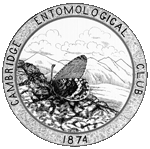
| January 2008: Psyche has a new publisher, Hindawi Publishing, and is accepting submissions |
Article beginning on page 93.
Psyche 12:93-94, 1905.
Full text (searchable PDF)
Durable link: http://psyche.entclub.org/12/12-093.html
The following unprocessed text is extracted from the PDF file, and is likely to be both incomplete and full of errors. Please consult the PDF file for the complete article.
19051 D YAK-NORTH AMERICAN GEOMETR^DK 9 3 LIFE HISTORIES OF NORTH AMERICAN GE0METRIDX.-LXII. BY HARRISON G. DYAR, WASHINGTON, D. C.
Leptomeris quinpelinearia Packard. This species occurred to me in the Platte Canyon, Colorado in July. Eggs obtained July 10 hatched in six days, the larvae were matured on August 8 and the imagoes began to emerge on August 23. The weather was very warm. I met with the species again at Kaslo, British Columbia, obtaining eggs on June 17 which hatched in eight days. The larvae grew very slowly, reaching the fourth stage in August and hibernated without becoming mature. The weather was cold and rainy all the season. B,y.
Laid loose, rolling about. Elliptical, one diameter less but not flat- tened, micropylar end truncated squarely and rather distinctly, the other end rounded.
About 12 straight, parallel, longitudinal ribs, elevated, .with a fine waved sharp crest, ending bluntly at the truncation, confused into reticulations at the other end Cross-striae fine, mostly parallel, a little raised, forming cells three times as wide as long. Micropylar end coarsely reticulate, a little bulging, the marginal reticulations joining the ribs which round over the edge of the truncation, being without bordering ridge. Uniformly whitish yellow, soon turning deep pink.
Size .65 x . i; x -4 mm.
Stage I. Head rounded, free, erect, sordid testaceous. Body elongate, Jender, normal, whitish, the dorsum broadly dark brown, diffusely narrowed at the anal end, obsoletely divaricate on joint 2; a similar broad subventral band staining the feet of joint 10; anal feet pale, thoracic feet partly brown. Tubercles and setae obscure, the setae short, narrowly club-shaped. Stage II.
Head rounded bilobed, erect, dull whitish spotted on the face, the vertex and sides thickly brown mottled; width .4 mm. Body slender, pale greenish, finely annulate.
Dorsal and subventral bands of dark purple brown, the latter segmentarily submaculate in darker; traces of a white edge to the dor- sal band and obscure line stigmatally.
Stage III.
Head rounded, oblique, clypeus whitish, lobes more yellowish, brown dotted in the vertical suture and in a darker stripe over the center of lobe; width .6mm.
Body slender, finely annulate.
Dorsal line dark brown,
composed of a fine subdorsal line and a large dorsal one which widens segment- arily to be confluent with the subdorsals; rest dull green, slightly silky shining; a faint subventral brown shade joining brown segmentary spots. Thoracic feet brown, abdominal ones green, the foot of joint 10 brown before. Stage IV.
Head whitish, a straight line of dark mottling over the lobes and Psiche 12:91-94 ( 1935). hup //psyche rinclub orgtW12-@I3 html
================================================================================
94 7 'S ITCHA7
[ October
a short paler line each side of the vertical suture; width .9 mm. Body moder- ately slender, straight, the central segments three times as long as wide and finely, numerously annulate.
Dorsum brown, undulating, cut by a dorsal line which is dark brown on the segments, yellowish in the incisures; a subdorsal black shaded line; sides and especially the subventral fold pale yellow; venter broadly black, pulverulent, cut by a broken subventral yellowish line. Feet
pale, the abdominal ones pale outwardly. Marks all pulvurulent and shaded.
General appearance dark brown with yellow line on subventral fold Stage V.
Head rounded, slightly bilobed, clypeus large, held obliquely flat, antennae large, projected; whitish on the clypeus, the vertex about the sutures brown, a nearly black mottled stripe over the center of the lobe, the space between yellowish white; sides white, sparsely brown mottled; width 1.2 mm. Body slender, normal, held straight, finely annulate; yellowish white, a broad diffuse, dorsal band, widened on the segments; narrow lateral, narrow stigmata1 and nar- row subventral brown-black lines, a broad segmentally widened ventral band sometimes pale or diluted medially. Lines pulverulent, not very definitely edged, more or less confluent. The subventral fold shows distinctly pale yellow. Some larvae were light brown, others heavily black marked, others partly red- brown, partly black.
Tubercles and setae small, obscure, spiracles black; tho- racic feet pale, sordid, appressed; abdominal ones approximated, whitish outwardly dark brown within.
Pupation in a slight cocoon at the ground. The larvae were fed on Poly-
gonum, their natural food plant not being determined, though I suppose they will feed on various low plants.
================================================================================
Volume 12 table of contents